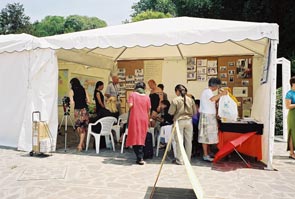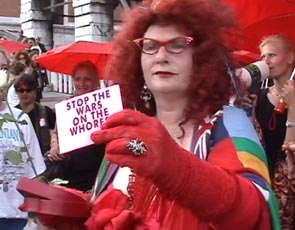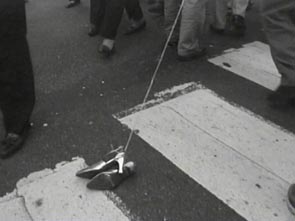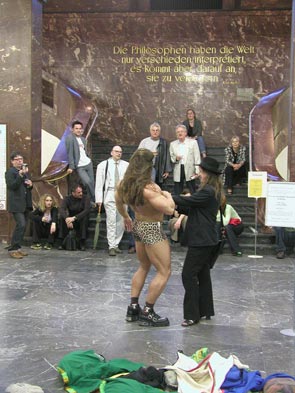Tadej Pogačar
This Is What You Want ... This Is What You Get
P.A.R.A.S.I.T.E. Museum of Contemporary Art
When we discuss the P.A.R.A.S.I.T.E. Museum of Contemporary Art, we cannot
overlook the radical changes that took place in the social context during
the 90's. This was a period of numerous commotions - from the 'fall of
communism' to the transition to the forms of early capitalism (locally)
from 'utopia' to 'consumption as a substitute for democracy' (globally).
At the projects that were carried out by the P.A.R.A.S.I.T.E. Museum of
Contemporary Art in various institutions of power, the mid 90's were denoted
by the demand for a more active involvement in the public sphere, both
within and outside of the art system.
The central idea is that of co-operation, establishing connections, new
models of production, etc. Apart from the early anonymous projects, the
Kings of the Streets represent the first project which explicitly exposes
the co-operation with a marginal social group and makes an issue of the
public space - its occupation, crossing, acceptable forms and contents,
monitoring, etc. Observation and documentation of the public space is
continued in the project Tales of the Two Cities and in the archives in
progress; in the archive Street Economy (2001- ) and the archive Public
Sculpture (2000- ), which documents the exchange of artefacts and material
goods in various urban locations.
Pamura Umetessi
CODE:RED
Outlaw poverty NOT
prostitution.
Carol Leigh
CODE:RED is a multidisciplinary,
multimedia, collaboration project, which discusses and researches the
informal economy models, self-organisation, global sex work and the white
slave trade. The introductory slogan by Carol Leigh, a renowned American
activist and fighter for the rights of sex workers, draws attention to
the basic characteristics of the situation into which the sex workers
are trapped during their work. Their work is illegal, however, due to
their poverty or the struggle for bare survival they are often forced
to do it. The economy of sex work is a vital source of income for numerous
segments of the population on all continents, segments that are excluded
from the dominant economy.
Most commonly the underprivileged social groups (women, children), who
symbolically and realistically live on the boarder or outside of society
and are stigmatised and without any basic human rights are forced into
prostitution.
The beginning of the
new century is marked by a new period of mass migrations. These migrations
have started already in the 80's and they are predominantly oriented towards
North America, Western Europe and Australia. The leaders in mass migration
and emigration are the Eastern Europe and former Soviet Union territories.
Most commonly the reasons for this can be found in ongoing wars and the
desire to improve their basic living conditions.
Following the fall of the Berlin wall we also witnessed the mass overflow
of Western Europe by migrant prostitution. The Western countries were
not prepared for this new situation. Those countries that have formed
an advanced policy towards sex work during the last few decades, found
themselves in a dilemma, for their legislation became outdated and useless
due to the changed conditions of the new global economy.
When we discuss globalisation,
we most often talk about the hyper-mobility of capital and services, the
influence that new technologies have on the production, distribution and
communication and less about the OTHER side of the same phenomenon: the
new international division of work, the new forms of slavery, new gender
divisions, etc., which are a consequence of the economic demands that
the developed world has from the third world countries. The occurrence
of the new international division of work is decisively dependent on the
so-called women's work, which is closely tied to migration and the current
phenomena of feminising migrations. In this context prostitution and the
white slave trade, i.e. the numerous forms of slavery, play an important
role. A great increase in this type of criminal activities and the redirection
of organised crime groups into this field point towards the great profit
that these activities create.
The globalisation of prostitution, as well as the logistics and communication
networks, which surround the community of migrant sex workers show that
we can not expect any great changes in the migration tendencies in the
future.
One of the basic questions is how to survive outside the mechanisms and the frame of global capitalism, which today structures the entire civilisation. The project CODE:RED researches also the issues of self-organisation of the marginal groups and communities, which take place outside the dominant social, economic and political frames. As in the past, there still exists a clear division in the contemporary society between those groups that are within the society and those that found themselves on the outside of it. In order to survive the excluded are forced into self-organisation. The self-organisation of the excluded is radically different from those, the identity of whom can enter a 'legitimate' social structure.
Support your local
hooker!
Carol Leigh
CODE:RED encompasses various forms of joint operation with experts, scientists
and activist groups, from research, activation, self-help to public manifestations,
actions, exhibitions, etc.
The project takes place within and outside the art context. P.A.R.A.S.I.T.E.
Museum of Contemporary Art co-operates at these actions according to the
principles of teamwork and establishes equal partner relations with groups
and individuals.
The project CODE:RED actively intervenes in the existing conditions of
things and searches for new ways and forms to change them. It also opens
the artistic space for dealing with the issue and changing social, economic
and political issues.
As far as content
is concerned the first four years of the CODE:RED project could be divided
into three phases: conceptual phase (1999/2000), which included the preparation,
study, concept, and similar; activist phase (2001- ), which included public
operation, establishing links, actions and interventions and the phase
of cartography of the global white slave trade (2004- ).
The short crossing of activities between the years 1999 and 2004 can be
structured around the following chapters: models of connections, autonomous
media, public actions, mobile architecture, cartography.
Models of connections
I. World Congress of Sex Workers and New Parasitism, Venice 2001 / The
Ultimate Sex Worker Conspiracy Soiree: Conference and Party, New York
2002.
The two most complex
examples of connecting were organised in 2001 and 2002 in the form of
'congresses' and 'conferences'. The I. World Congress of Sex Workers and
New Parasitism was the first public manifestation of the CODE:RED project.
Due to the excellent organisation the action achieved great attention
and extensive media coverage from the official media. The project emerged
as a consequence of our co-operation with Comitate per I Diritti Civili
delle Prostitute from Pordenon, one of the leading organisations for the
protection of sex workers in Italy.
The I. World Congress of Sex Workers and New Parasitism took place within
the frame of the 49th Venice Biennial, between 6th and 8th June 2001,
on a public space at Giardini in a tent, or the so-called Prostitute Pavilion
(Padiglione delle Prostitute). The list of the participating groups and
organisations was impressive and included groups, activists and individuals
from Taiwan, Thailand, Cambodia, Vietnam, Italy, Germany, USA and Australia.
The congress was conceived as a creative frame for connections, exchange
and informing.
The activists and groups presented the current situation on the sex market,
the strategies of the fight for civil rights of sexual workers, however,
their emphasise was on the presentation of the principles of organisation,
education, self-help and protection. This was performed through conversations,
video projects, exhibitions, documentary publications, performances, activist
street theatre, agitation music appearances, etc.
One of the main emphasis was oriented towards Asia, where the sex industry
has been experiencing one of the greatest boosts during the last few years.
The Taiwanese activists from the group COSWAS presented the successful
rebellion of Taiwanese sex workers. Through demonstrations, media appearances
and inventiveness they achieved a victory against the town authorities
in Taipei, who tried to adopt a new restrictive legislation.
Apart from the Cambodian activists (CWDA) and those from Vietnam also
a representative from the Global Alliance Against Trafficking in Women
(GAATW) from Bangkok participated. GAATW has deep roots in the fight against
abusing prostitutes in Asia and heads an educational programme as well
as medical and legal help, etc. In 1996 GAATW adopted the so-called Dutch
model, which understands sex economy as an industry in which all participants
have the right to legal protection by their syndicates.
The main purpose of
The Ultimate Sex Worker Conspiracy Soiree: Conference and Party, which
took place as a part of the CODE:RED USA project in the bar TRUE in New
York was to connect and create a direct reaction towards the local, national
and international problems of sex work.
At the conference representatives from various organisations from New
York, Baltimore, Boston, San Francisco and Los Angeles participated. The
conference was organised in co-operation with organisations that fight
for the rights of sex workers (PONY, COYOTE and SACRD), homosexuals (HOOK)
and transsexuals.
Through excellent mutual co-operation between the groups that fight for
the right of different sexually oriented and operate within all branches
of the sex industry a very positive co-operative and solidarity atmosphere
was created.
Due to its criminal status in USA sex work and prostitution are experiencing
a special transformation, for they are moving from the social public space
into the virtual space. Following the terrorist attacks in September 2001,
the sex workers were exposed as a fairly suspicious and problematic group
and the city mayor practically gave them the same status as terrorists.
The Ultimate Sex Worker Conspiracy Soiree: Conference and Party was organised
in co-operation with the most important activist groups and held over
20 speakers.
The theme of the short discussions and round tables, which were attended
by experts, scientists, activists and sex workers were the following:
the rights of sex workers, gender and sexual identity, race and class
in sex work.
The performances and short appearances, which deal with the sex industry
were contributed by writers (amongst others also Tracy Quan and David
Sterry), poets, actors, artists and the radical activist unit.
Autonomous media
The homepage CODE:RED USA / Sex Worker newspaper / A Monument to the Unknown
Prostitute, Ljubljana 2002
The homepage CODE:RED
USA was conceived as a basic informational and communication tool of the
project, for due to its anonymous nature (formal legislation) the information
as regards the actions was not mediated through the public media. The
homepage was officially accessible to the general public on the Internet
from midnight of 15th April 2002 CET onwards, i.e. 6 am New York time.
The homepage included the basic information on the project, the most up-to-date
announcements of actions and interventions, a public forum, the project
history and links.
During the Congress in Venice the first thematic issue of the Sex Worker newspaper was published. The newspaper was distributed free of charge to all passers-by and the public of the A + A Gallery. In it one could find the official manifests of the P.A.R.A.S.I.T.E. Museum of Contemporary Art and Comitato per I Diritti Civili delle Prostitute, information on the congress programme, the participants, etc. The second thematic issue of the newspaper was published at the project CODE:RED Sector Zagreb and dealt with the issues of global migrations and presented a new architectural model of mobile architecture intended for independent sex workers.
The Monument to the
Unknown Prostitute was set up between 1st and 5th February in the centre
of Ljubljana. It was set up within the frame of the Agent of Change project
in the International Centre of Graphic Arts. The Monument to the Unknown
Prostitute was accompanied by the round table Globalism and New Exclusions
and the public unveiling, which summarised all the elements of the symbolic
opening ceremony.
The form of the 'temporary monument' deals with the issue of the public
space, a specific location and the idea of monumentality. The 'temporary
monument' is fragmentary and heterogeneous. It emerges spontaneously,
non-linearly and subjectively. At its construction it uses recycling,
collages, direct information, participation and everyday, used or cheap
materials: one could say that it follows the ethics and aesthetics of
the everyday and temporariness.
Public actions
Red Umbrellas March, Venice 2001 / Golden Shoes of Times Square, New York
2002 / Stripping with Marx, Berlin 2002
The Red Umbrellas
March is an example of a manifestation march, which actively and publicly
demonstrates its presence in city. In order for it to be better heard
and seen it uses requisites, such as megaphones and red umbrellas, thus
loudly drawing attention to its situation and not differing from the usual
forms of political demonstrations. The march with the Congress participants,
local organisations and accidental sympathisers started at the Congress
tent and went to the A + A Gallery, going through the city centre on its
way. The march crossed the city in order to cause an interruption, a sound
and visual disturbance in the routine and continuity of the city panorama.
Apart from the realistic, manifestation side it also had an important
symbolic side.
With the joint walk the new geographic points of the city were defined,
the points that are otherwise forgotten. This is the geography of the
social history of sex workers, from the famous Venetian courtesans Veronica
Franco and Gaspara Stampa right until today.
The action Golden Shoes of Times Square was carried out on 1st May 2002
on Times Square in New York. Similar to The Red Umbrellas March this action
also took advantage of walking, but in a different way. In this action
walking was an intimate act and the action took place only for the attentive
passer-by, for the actor was lost amidst the masses of visitors and tourists.
The walk took place at a slow pace and in silence. The actor walked around
the entire square, and while doing so he pulled a pair of golden women's
shoes behind him on a string. The Times Square location was not chosen
by chance. This is an important symbolic location of the New York sex
industry, which was in the second half of the 80's changed into a symbol
of its criminality and in the beginning of the 90's into a symbol of its
disappearance. Since 1985 the city government has started to publicly
incriminate peep shows, theatres and cinemas that showed films with sexual
content. All of this was performed in the name of 'safety and health'.
In 1990 the mayor of New York, Rudy Giuliani (with the help of the Walt
Disney corporation) 'cleared' the city centre with a series of new restrictive
laws.
In his work Times Square Red, Times Square Blue Samuel R. Delany states
that the decision that the Times Square should be 'cleared' had little
in common with the true struggle for public health. It was mainly based
on corporate greed. At the same time it announced the victory of the new
repressive mentality currently governing New York, which in the name of
hygiene forbids social contacts and communication between people of various
races and classes on an urban public space.
The public performance
Stripping with Marx was conceived within the frame of the project Ostensiv:
Free Art of Eastern Europe, in the great entrance hall of the Humboldt
University in Berlin, in front of a staircase, which carries the famous
quote by Karl Marx: 'Die Philosophen haben die Welt nur vershieden interpretiert,
es kommt aber darauf an, sie zu verendern.'
A local stripper performed in this performance. For his performance he
used a number of costumes: from a monster (the unknown, evil) he changed
into the figure of male film and literary heroes, who stereotypically
present power, goodness and the natural, i.e. Superman and Tarzan. The
University location (reproduction of knowledge), quote (demand for action
and the change of the situation) and sex worker (representation of male
stereotypes) created an interesting triangle of meanings and divisions.
Mobile architecture
Working Unit Z 01, Zagreb 2003
'What does the placement of exclusively economic zones in the centre of
Zagreb really mean?'
WORKING UNIT Z 01
is an architectural plan, which arose in co-operation with the architect
Anja Planišček within the frame of the project CODE:RED Sector Zagreb.
With the co-operation of the historian Petra Hoblaj and the International
Organisation for Migrations (IOM) we prepared a round table on forced
migrations, which are very common in the territory of the Balkans.
Through the model WORKING UNIT Z 01 we (for the first time) dealt with
the housing problem of a marginal group. The new model of mobile architecture
should function as a basic module, completely adjusted to the independent
work of sex workers. The camper WORKING UNIT Z 01 can be easily assembled,
is mobile and adjustable. It enables simple transport and simple inclusion
into the existing energy sources and sanitary pipelines or can be adjusted
for self-provision systems. A number of linked units can form larger units
or even well rounded urban solutions. The interior of the basic module
is composed from five zones: the hygiene zone, the reception room, the
lounge, the light zone and the working zone. It is furnished with functional
furniture, a bathroom, video and audio appliances and a security-communication
system, which enables a direct link with the police.
For the first prototypes we selected three potential urban and suburban
locations in Zagreb and its suburbs, where we also developed this model.
In most aspects they were in line with the functional demands and parameters
(accessibility, safety, infrastructure, autonomy) for the setting up of
the first complexes of working units.
The WORKING UNIT Z 01 module was inspired by numerous (utopic and real)
urbanistic and architectural models from the late 60's, for example the
concept of the Plug-in City by Peter Cook or the diametric concept of
the New Babylon, which were conceived as collective, social projects and
operated predominantly as a specific projective frame for creating new
situations.
Cartography
MONAPOLY - A Human Trade Game, 2004
In the early 70's
Öyvind Fahlstrom created works that invited the spectator to reach into
them, to actively change them. Amongst the best known was also the Monopoly
series (CIA Monopoly, World Trade Monopoly, Indochina Monopoly). These
were all remodels of the original game, which critically dealt with the
American foreign policy, global trade, the arms industry and the topography
of American military interventions throughout the world.
The game MONAPOLY is also a remodelling of the most famous capitalist
game. Visually it follows Monopoly and the basic scheme of the game, but
the contents are completely new. While playing the players obtain new
information on the global sex work, important locations, activist organisations,
organised crime gangs that organise the white slave trade, etc. The players
can finance the construction of a safe house, support the operation of
groups that are fighting for the rights of the sex workers and their programmes
or can save a sex slave from Moldova.
MONAPOLY is a new cartography of sex work and the white slave trade. Instead
of accumulating capital, it explains to the players the geopolitics of
sex work in the period of global capitalism and new economy.
 |
I. svetovni kongres seksualnih delavcev in Novega parazitizma, Benetke, 2001 / The Ultimate Sex Worker Conspiracy Soiree: Conference and Party, New York, 2002 |
 |
Pohod rdečih dežnikov, Benetke, 2001 |
 |
Zlati čevlji Times Squara, New York, 2002 |
 |
Slačenje z Marxom, Berlin, 2002 |